Picking out the right switch for your keyboard is a difficult decision.
For a first time mechanical keyboard buyer, sorting through all the different Cherry MX choices can cause be a little overwhelming and headache-inducing, but we’re here to help.
The purpose of this guide is to cut through all of the confusion and help you pick out the perfect Cherry MX option whether it be for typing, gaming, programming, or anything under the sun.
We’ll go over all the different Cherry MX colors along with a deeper dive into the nitty gritty details.
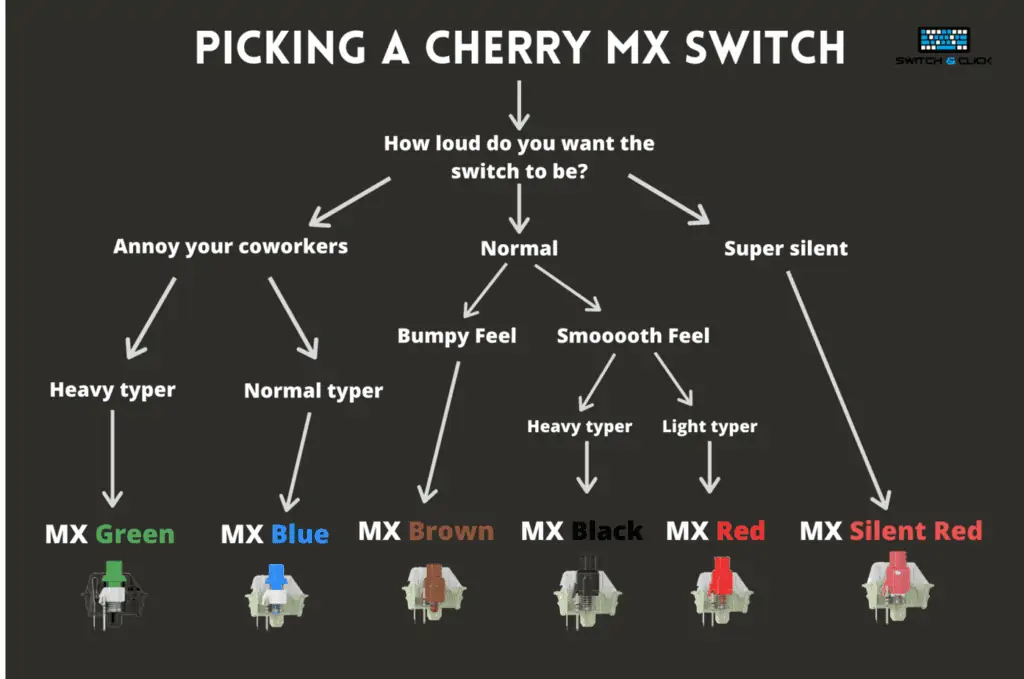
The Quick Guide to Cherry MX
Here’s a quick overview of all the common switch colors and what they mean.
| Color | Description | Usage |
|---|---|---|
| MX Red | Smooth with light resistance. No bump and relatively quiet. | Gaming |
| MX Black | Smooth with heavy resistance. No bump and relatively quiet. | Gaming |
| MX Brown | Bumpy with medium resistance. Moderate sound level. | Typing/Gaming |
| MX Clear | Bumpy with heavy resistance. Moderate sound level. | Typing/Gaming |
| MX Blue | A clicky and bumpy with medium resistance. Very loud. | Typing/Gaming |
| MX Green | A clicky and bumpy with heavy resistance. Very loud. | Typing/Gaming |
We’ll do a deeper dive into each Cherry MX choice and give our recommendations on their usage.
We’ll include sound tests and pictures of each choice.
Different Actuation Types
Switches can be broken down into three main actuation types: linear, clicky, and tactile. Here is a brief description of what they mean:
Linear: Smooth and consistent keystroke with a quiet noise.
Tactile: A small bump on each keystroke with a moderate noise.
Clicky: A small bump on each keystroke with a loud click noise
We’ll go over the Cherry MXs in each category and explain the differences.
Cherry MX Clicky Switches
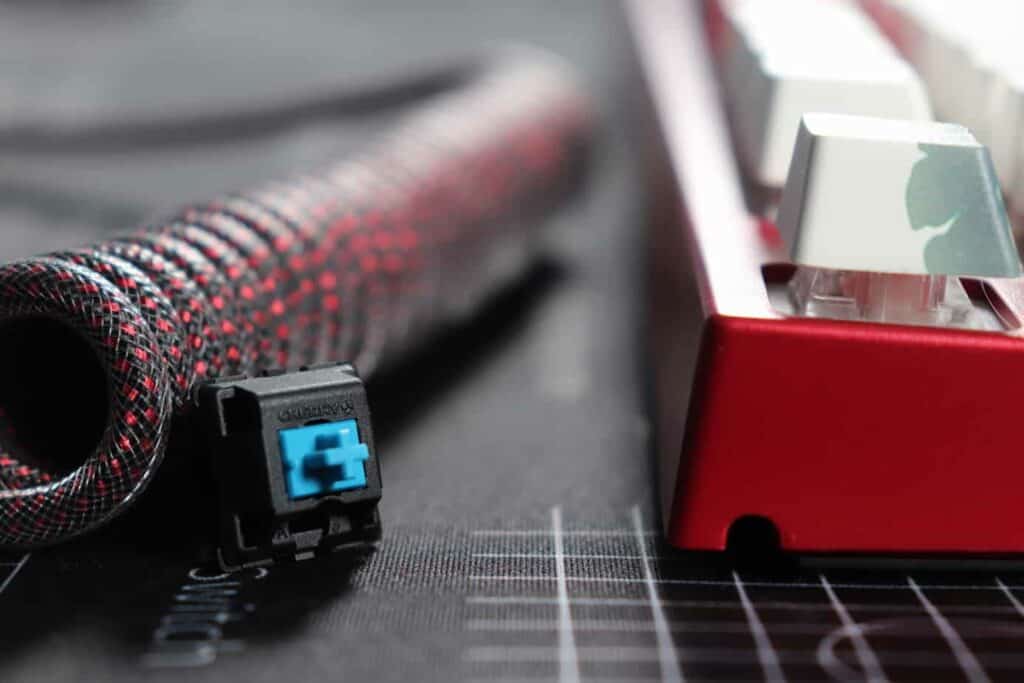
Cherry MX Blue vs Green vs White
Ah yes, clickys, the bane of my existence.
I have been stuck working next to a person using clickys in the past and I still hear the click clacks in my nightmares to this day.
Jokes aside, clickys are a viable option for those who like a keyboard that is LOUD. These make a clicking noise on every keystroke and give you that extra auditory feedback to let you know everything is working a-okay.
Clickys are perfect for strictly home usage. Trust me, do not be that guy that brings them to the office and annoys everybody to no end (looking at you KEVIN).
Although I will be forever turned off to them, they are a good option if you want to keep your family up at night and want the neighbors to hate you. (I can’t write section without saying bad things about clicky switches)
In all honesty, Cherry MX does not have the best clicky options due to their click jacket design, instead I would recommend the clicky Kailh BOX instead. You can read more about clickys here.
Due to their easy availability however, Cherry MX Blues are a great option in a pinch.
Cherry MX Blue

Type: Clicky Feel/Sound: Bumpy and Loud Actuation Force: 60g Bottom-Out Force: 60g Actuation Distance: 2mm Travel Distance: 4mm
Cherry MX Blues are the hallmark clicky option. On every keystroke they make a click noise and then bounce right back ready for some more clicking. You’ll experience a pronounced tactile bump as well. These are perfect for those who like to game/type in a confined space with nobody else around.
Some gamers find the Blues to have a distracting and inconsistent feeling when button-mashing, so if you’re playing super competitive games, I wouldn’t recommend them.
Cherry MX Blues have an actuation force of 60g and a bottom-out force of 60g, which is ideal for someone with normal typing habits. The total travel distance is 4mm while the actuation distance is the normal 2mm.
Cherry MX Green

Type: Clicky Feel/Sound: Bumpy and Loud Actuation Force: 80g Bottom-Out Force: 90g Actuation Distance: 2mm Travel Distance: 4mm
Another clicky pick is the Cherry MX Green, also perfect for annoying everybody with. The Greens are significantly heavier than the Blues and much less common to find.
The Cherry MX Greens have a similar click noise to the Blues but with a more pronounced bump and heavier feel overall. Great for those with lead fingers who bottom out the lighter springs.
The MX Greens have an actuation force of 80g and a bottom out force of 90g. Definitely not a good pick for those who type lightly. The total travel distance of the MX Greens is 4mm with an actuation distance of 2mm.
Cherry MX White

Type: Clicky Feel/Sound: Bumpy and Moderately Loud Actuation Force: 80g Bottom-Out Force: 90g Actuation Distance: 2mm Travel Distance: 4mm
Cherry MX Whitess are very similar to Greens and are much less common. They are very difficult to find and in my opinion sound very strange. Whites sound like a muzzled Green and feel almost tactile. A very strange experience overall.
There isn’t much good information out there about the actuation and bottom-out forces, but I think it’s safe to assume it’s the similar to the MX Greens. So, about an 80g actuation force and 90g bottom out.
The travel distance and actuation distance are the same as any other Cherry MX option with a 2mm actuation and 4mm total travel.
Linear Cherry MX Switches
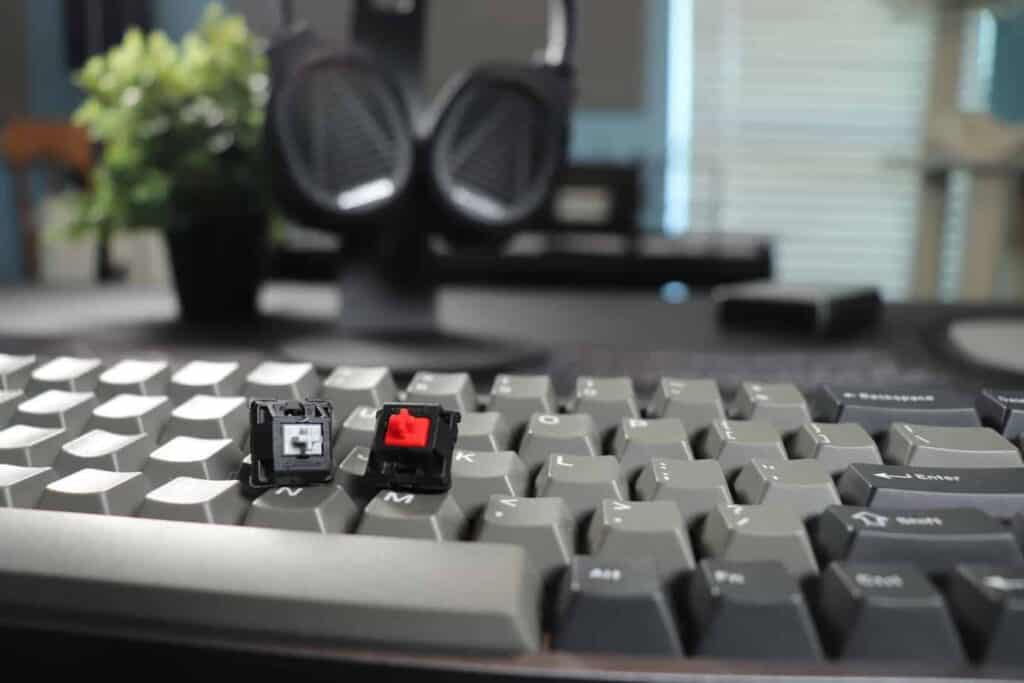
Linears are buttery smooth and offer a consistent and even keystroke. These options have no bump, which makes them perfect for those who want smooth typing experience.
Linears are typically regarded as the best for gaming due to the consistency when entering multiple keystrokes in a short period of time (AKA button mashing).
You can also use linears for typing, but if you’re not used to this style of switch you may experience “bottoming out”, where you press the key too hard and slam your fingers down. But after a while, you’ll adjust to the different feel.
In my experience, I have found the Cherry MX linears to be overrated and slightly overpriced. I find the Gateron linears to be much smoother and cost efficient, plus they have more options available. But to each their own.
Cherry MX Red
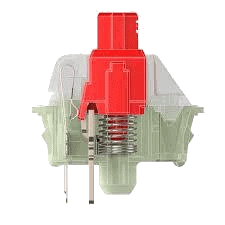
Type: Linear Feel/Sound: Smooth and Quiet Actuation Force: 45g Bottom-Out Force: 75g Actuation Distance: 2mm Travel Distance: 4mm
Cherry MX Reds are a linear actuating switch with a relatively light spring force. These are perfect for gaming, although if you have lead fingers, these might not be the best option.
Cherry MX Reds are relatively quiet, more-so than the tactile and clickys such as the Brown or Blue. They have a 45g actuation force with a 75g bottom out force.
The total travel distance on the MX Reds is 4mm with an actuation distance of 2mm which is standard for Cherry MX.
Read more about our favorite Cherry MX Red keyboards.
Cherry MX Black

Type: Linear Feel/Sound: Smooth and Quiet Actuation Force: 60g Bottom-Out Force: 85g Actuation Distance: 2mm Travel Distance: 4mm
Cherry MX Blacks are nearly identical to the Cherry MX Red’s except they have a higher actuation force. Each Black will feel heavier because the spring inside is stiffer, which is perfect for those who have a heavy keystroke.
Cherry MX Black’s come with an actuation force of 60g and a bottom out force of 85g, which puts it at around 10-15g heavier than the Reds.
Much like the Cherry MX Red’s, the Blacks are perfect for gaming and can be great for typing as well, although they are a bit trickier to find on a keyboard.
Fun Fact: The original vintage Cherry MX Blacks are considered to be the holy grail by mechanical keyboard enthusiasts (yes, this is a real hobby).
Before the production methods were changed, Cherry MX Blacks were much smoother to use. It can be quite tricky to get your hands on vintage MX Black’s since they are no longer in production.
Tactile Cherry MX Switches
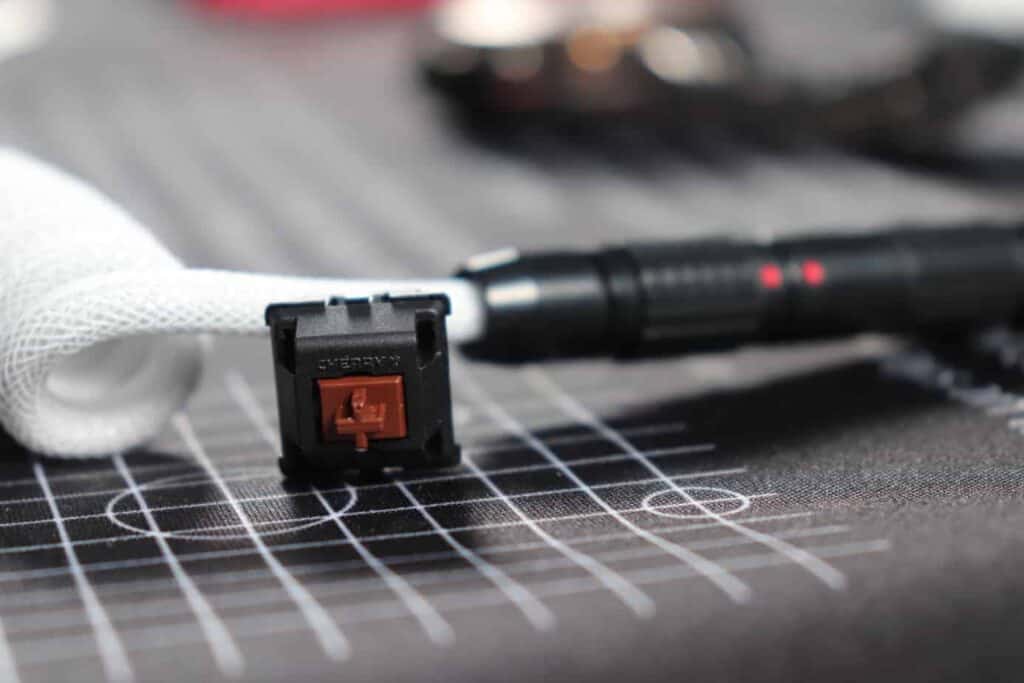
If you’re coming from a normal non-mechanical keyboard, tactile will feel very familiar to you. A tactile switch has a bump on each keystroke which provides tactile feedback to let you know the key was registered.
This style is perfect for those who need an option for typing because the bump provides great feedback and the overall noise level of tactiles is not too high (although louder than linear).
Some gamers may say the tactile bump can be distracting when trying to press the same key really fast, so keep that in mind.
Cherry MX Brown

Type: Tactile Feel/Sound: Bumpy, Moderately Loud Actuation Force: 55g Bottom-Out Force: 60g Actuation Distance: 2mm Travel Distance: 4mm
Cherry MX Browns are the most common option currently available; they are a perfect fit for typing and can be great for gaming as well.
With a tactile actuation, they are slightly louder than a linear due to the extra friction at the tactile bump. You’ll basically hear the bump and the bottoming out on each keystroke, but it will not be quite as loud as a clicky option.
If you work in an office, I advise against using Browns unless your workspace is busy and loud. Although Cherry MX Browns do not click, they still put out a decent amount of sound on each keystroke.
Although being tactile, many complain that the bump is not strong enough, and for that reason they prefer other tactile options such as the MX Clear.
Cherry MX Browns have a total travel distance of 4mm along with a 2mm actuation distance. The actuation force is 55g with a bottom out force of 60g, which makes them have a very normal feeling.
Cherry MX Clear

Type: Tactile Feel/Sound: Bumpy, Moderately Loud Actuation Force: 65g Bottom-Out Force: 95g Actuation Distance: 2mm Travel Distance: 4mm
Cherry MX Clears are another tactile switch option, although they are only available on a select number of keyboards. MX Clears are a great option if you find the Cherry MX Browns to not be heavy enough, or if you feel the bump is not strong enough.
Many have complained that Cherry MX Browns don’t do anything good.
Cherry MX Clears are perfect for heavy typists who need to the extra support to keep from bottoming out and limit finger pain. If you have a lighter keystroke, this style may fatigue your fingers, so it’s not for everybody.
Clears have an actuation force of 65g and a bottom-out force of 95g. Along with a travel distance of 4mm and an actuation distance of 2mm. As you can see, this choice is not for the faint of heart, but it can be incredibly comfortable for the right person.
Cherry MX Grey

Type: Tactile Feel/Sound: Bumpy, Moderately Loud Actuation Force: 80g Bottom-Out Force: 120g Actuation Distance: 2mm Travel Distance: 4mm
The Cherry MX Grey is the equivalent of unicorn, you may spend your entire life trying out different keyboards, but unless you go out of your way to buy these specifically, you may never find one.
Greys are another variation of a tactile from Cherry, they are a slight derivation from the MX Browns, except they have a larger bump and are slightly quieter.
From my experience, they feel like a scratchier, heavier version of a Cherry MX Brown. You’re better off skipping this altogether and opting for a Brown or Clear switch instead.
The MX Grey has an actuation force of 80g and a bottom out force of 120g, which is quite intense.
The only niche usage for this option is if you type super heavy like an ogre (I don’t know how ogres actually type, they could be very gentle) and you prefer a big tactile bump.
Cherry MX Specialty Switches
Now that we’ve gone over all of the more common Cherry MX colors, let’s talk about the really juicy stuff, their specialty choices.
Are they really that much different from the main lineup, or is all marketing?
Let’s find out.
Silent Switches

Cherry MX Silents, the perfect pick for peace and quiet. The silent picks are nearly identical to the main lineup except they come with rubber dampening on the stem to lower the decibel output on each keystroke.
Cherry MX Silent Red

Type: Linear Feel/Sound: Smooth and Extra Quiet Actuation Force: 45g Bottom-Out Force: 75g Actuation Distance: 2mm Travel Distance: 4mm
Cherry MX Silent Black

Type: Linear
Feel/Sound: Smooth and Quiet
Actuation Force: 60g
Bottom-Out Force: 85g
Actuation Distance: 2mm
Travel Distance: 4mm
The rubber will reduce the sound level when the stem strikes the lower housing and when the key is released and springs back up.
Cherry MX claims the silents reduce the sound level by a whopping 30% compared to their non-silent sister, but from our testing it’s only 16%.
While 16% sound reduction is significantly less than what’s marketed by Cherry MX, the sound difference is quite drastic, so they can be an excellent option for those who need a silent workstation.
The silents are offered in either Cherry MX Silent Red or Silent Black form, so you’ll be stuck to only linear. Unfortunately, Cherry does not currently produce a silent tactile option, so you’ll need to look at the Gateron Silent Brown instead.
From my experience, silents sound much better, but they feel a bit rubbery upon bottoming out. The overall feel is slightly worse, but the sound makes up for it. Deciding if you want this style comes down to what you prefer more: sound or feel.
Speed Switches:
Cherry MX Speeds are another interesting option from Cherry. These switches have a shorter actuation distance, which means it does not need to be pressed as far for the key to register.
The only speed option currently available is the Cherry MX Speed Silver, which has an actuation distance of 1.2mm and a total distance of 3.4 mm. This puts the actuation distance at 0.8mm shorter than a normal mechanical keyswitch.
Cherry MX Speed Silver
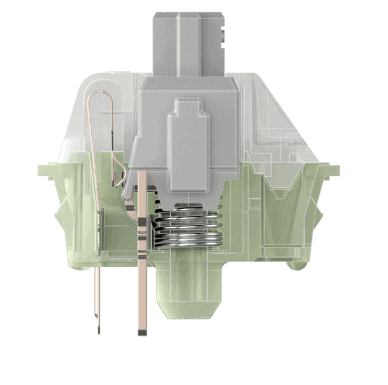
Type: Linear Feel/Sound: Smooth and Quiet Actuation Force: 45g Bottom-Out Force: 80g Actuation Distance: 1.2mm Travel Distance: 3.4mm
In theory, this type should be better for gaming because the shorter distance could equal a faster reaction time.
But based on our own testing, however, we found that these had little to no improvement in our reaction times.
| Type | Actuation Distance | Actuation Type | Average Reaction Time |
|---|---|---|---|
| Cherry MX Red | 2.0 mm | Linear | 0.2466 seconds |
| Cherry MX Speed Silver | 1.2 mm | Linear | 0.2468 seconds |
We found out that a shorter actuation distance doesn’t actually reduce the reaction time, in fact, I found the Speeds to make my gameplay worse because the different actuation distance threw off my timing in game.
I’m not saying Speed switches are bad, I just didn’t feel the benefits that Cherry said would be better for gaming. In addition, we found typing with a Speed Silver to feel more uncomfortable as the short distance led to more bottoming out.
I personally wouldn’t recommend them for gamers and especially not for typists. You’re better off with a normal ol’ linear.
Cherry MX Low Profile Switches
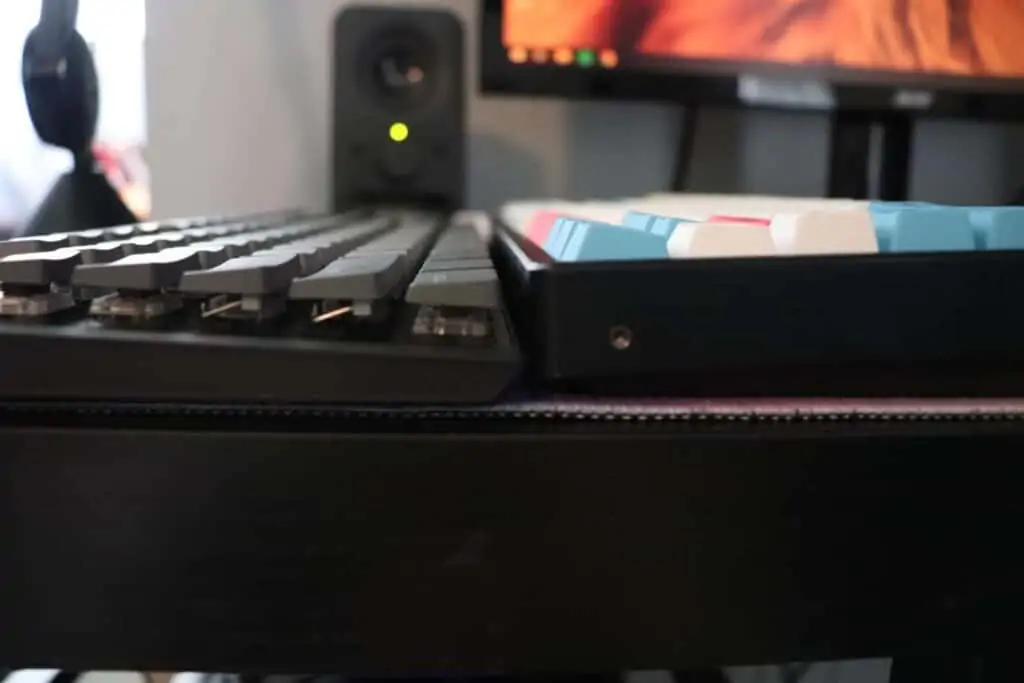
Low profile keyboards are quite the rage nowadays, especially amongst the gaming community. These keyboards are typically thinner and have a shorter keystroke.
Cherry MX Low-Profiles are made specifically for this style of keyboard, as they offer a shorter actuation distance along with a shorter travel distance.
Similar to the speeds, we have found low-profiles to not have a noticeable impact on gaming reaction time.
As we mentioned earlier, we have found no relationship between a shorter actuation distance and a faster reaction time, which leads me to believe these are purely marketing. Although a pretty interesting attempt to improve normal switches for the purpose of gaming.
If you do find mechanical keyboards to be too thick, however, low profile keyboards equipped with these can save your wrists from having to raise your fingers so high when typing and gaming. That’s really the only application where these style of keyboards make sense.
We have found low-profile keyboards to be quite uncomfortable to type on, and are not great for writing long essays (or in my experience a 4000+ word article), although some weirdos find them enjoyable because they feel similar to typing on a laptop.
There are two low-profile options currently available, the Cherry MX Low-Profile Red and the Speed Silver. They are slightly different with the speed silver having a shorter actuation distance.
Cherry MX Low Profile Red

Type: Linear Feel/Sound: Smooth and Quiet Actuation Force: 45g Bottom-Out Force: 80g Actuation Distance: 1.2mm Travel Distance: 3.2mm
Cherry MX Low Profile Speed Silver

Type: Linear Feel/Sound: Smooth and Quiet Actuation Force: 45g Bottom-Out Force: 80g Actuation Distance: 1.0mm Travel Distance: 3.2mm
Explaining the Different Terms
- Actuation Type: this indicates the behavior of the key and whether it is linear, tactile, or clicky. Whether the keystroke is smooth, bumpy, or loud will determine its classification.
- Actuation Force: this refers to the force required to make the key press down and register the keystroke to the computer. I.e.: how hard you must press the key. This measurement of (g) refers to grams.
- Actuation Distance: this indicates at which point the stem is pressed down hard enough to translate information from keyboard to computer. Most options will have an actuation point of around 2mm unless it is low-profile or speed, in which case the activation point is shorter. This pressure point is measured in millimeters (mm).
- Travel Distance: The travel distance is the distance from the top of the key (un-pressed) to the bottom of the key (when pressed all the way down.) The point at which the switch is fully bottomed out is the end of the travel distance. It is also measured in millimeters (mm).
- Lifespan: this refers to the number of keystrokes that can be pressed before it deviates from factory conditions. Most will actually last longer than the lifespan, and many prefer the feel of a well-used switch to a brand new one.
The Anatomy of a Cherry MX Switch

- Upper Housing: The upper housing rests on top of all the other components and holds everything together with four small clips. It’s possible to take it apart by unclipping the plastic parts. The upper housing comes in two different styles on Cherry MXs, either clear or a solid black plastic. If you have RGB lights, the clear housing will allow the light to shine through.
- Stem: The stem is the skeleton of the design. This component moves the most and will glide up and down. After reaching a certain distance the stem will actuate the key and register a keystroke.
- Spring: The spring provides all of the resistance and can affect the overall stiffness. A heavy key will have stiff spring and vice-versa. A bent or twisted spring can cause a lot of extra pinging noise.
- Lower Housing: The lower housing is what stores all of the complicated components. There is a metal leaf in this section which is responsible for the tactile bump/click . If this part is bent or damaged it can ruin it. On the underside is a few metal and plastic pins which get soldered to the PCB to secure the connection.
Is Cherry MX the Best Option Available?

Now that we’ve gone over all of the different picks and the common lingo, let’s talk about how they compare to the competition.
Cherry MXs absolutely have the best quality standards and go through all sorts of rigorous testing. Their entire testing process is quite impressive and are stress-tested in extreme temperatures and are pressed multiple times by a machine to validate how long they’ll keep their force curve.
Cherry MXs have a lifespan of 100 million keystrokes, which is bonkers. They double the lifespan of their competitors which usually is around 50 million.
And even after the 100 million keystrokes, they will usually still work, they will just feel slightly different. Some enthusiasts actually prefer having a broken-in switch because they tend to feel smoother and less scratchy.
From a quality standpoint, Cherry MX wins hands-down.
For feel and sound, however, there is a bit more competition. While Cherry MXs are precisely toleranced, they do tend to feel scratchier than the competition. In addition, they have a premium price which can double or triple the cost from other manufacturers.
Gaterons for example, typically have a smoother keystroke and are way cheaper, but don’t have the high durability standards in exchange for the lower price.
Whether you want a smoother feel or higher durability standards, it’s up to you what you value more.
How to Improve your Cherry MXs
After purchasing a mechanical keyboard with Cherry MXs there are a ton of cool mods you can do to improve the feel and sound.
Try Applying Lubricant
Lubing is a great way to limit the amount of spring ping and scratchiness while simultaneously making them feel smoother and sound better. This is the best improvement you can make, hands down.
Lubing your keyboard can be quite a project, so we’ll link to a few guides we have written on this process. Trust us, the difference is night and day. There are different techniques based on what tools you have available and if your keyboard is hot-swappable or not.
Here are the guides:
Install Film For Less Wobble
When keyboards are manufactured there a slight deviations in the product that make the switches not fit perfectly snug. This can result in extra wobble and movement when typing.
To make them extra secure and stable, you can install film which will reduce the amount rattle and make them feel better as well. We don’t have a guide on this process, so we’ll link you to a super helpful video. This process also requires you to open them up so we’ll show you our guide.
Should You Trust Our Opinions/Analysis?

I’ve pretty much plastered you with everything I know about Cherry MX, which took a bit longer than expected. If you’ve read all this, how do you know you trust can me?
Well, you don’t. I’m just some person on the internet talking about switches. However, I have tried hundreds of different options at this point, and I have all of the different Cherry MX’s sitting in front of me, so I know from personal experience how they feel and sound.
We’ve also done our own independent testing of the different switch types and performed all of the different modifications, so we can say from experience if they help or not.
While I interjected my opinion in several places, there is no right or wrong picks. It comes down to personal preference and what you plan on using it for. I just tried to remove the mystery and confusion surrounding the them, so you can learn all of the subtle differences.
Conclusion
Well, that was a ton of information. We gave you a quick overview of Cherry MX colors, and broke down what clicky, linear, and tactile means, along with more details of each individual option. The main Cherry MX lineup consists of: Red, Black, Brown, Clear, Grey, Blue, and Green.
There are also specialty choices offered such as the Cherry MX Silent Red, and Silent Black, which are both awesome quiet options. In addition, you could get a speed or low-profile option, which both have a shorter actuation distance to supposedly improve gaming reaction speeds (which we personally think is baloney).
We also dug into the different terms such as actuation distance, travel distance, etc, and explained all the complicated foreign-sounding lingo commonly throw around in the keyboard world.
The part anatomy went over the various components including the upper/lower housing, stem, spring, etc.
Overall, Cherry MXs are a great option if you’re looking for a long-lasting, incredibly durable switch, but they do slack a little when it comes to the overall feel and sound. In addition, they are quite pricey, so they are not the best pick for someone on a budget.
